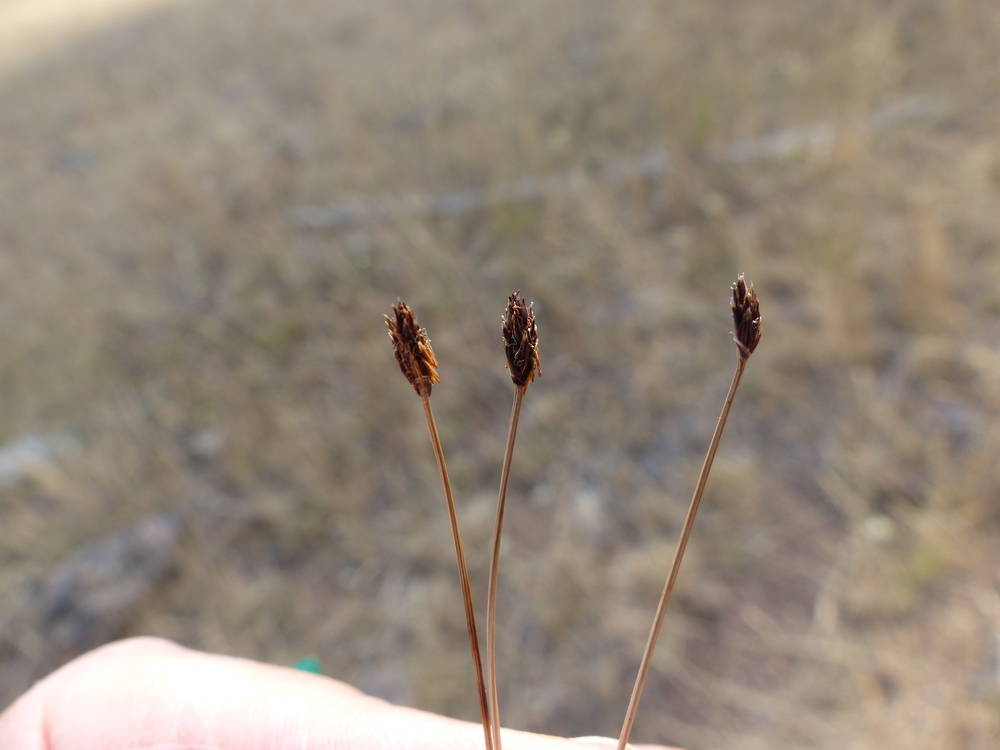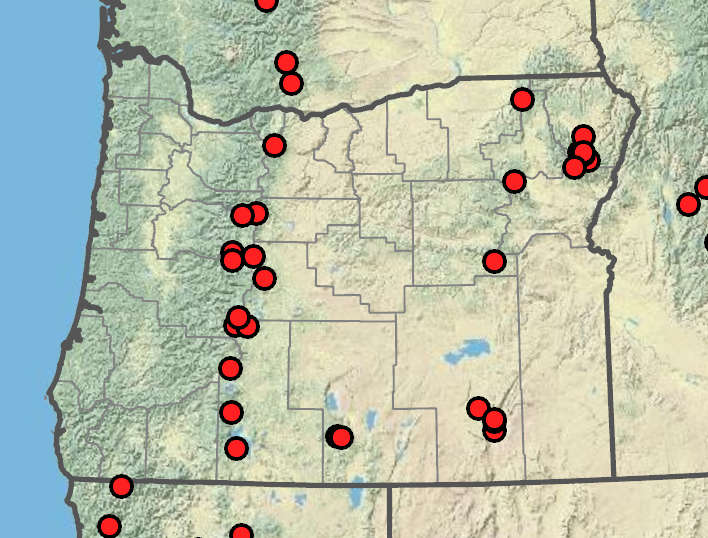Eleocharis bolanderi
Eleocharis suksdorfiana
Bolander's spikerush
Suksdorf's spikerush
subterete, 10–30 cm × 0.3–0.5 mm.
subterete to slightly compressed; to 2 times as wide as thick; (5)10–40 cm × 0.5–1.2 mm; culm tufts not proximally bulbous.
ovoid, 3–8 × 2–3 mm;
proximal scale clasping; entire, subproximal scale with flower; floral scales 8–30, 4–5 per mm of rachilla, 2–3 × 1.5 mm;
apex entire; acute, often keeled in distal part of spike.
with proximal internodes shorter and thicker than those in the middle of the spike, 5–10 × 2–4 mm;
proximal scale usually empty, 3–5 mm, usually 50% or more as long as spike; floral scales 8–12 per spike, 3.5–5 × 2–2.5 mm.
perianth bristles 3–6, often unequal; from rudimentary to 50% of achene length;
anthers 0.9–1.4 mm;
stigmas 3.
perianth bristles 6; equal; the longest equaling achene to exceeding tubercle;
anthers 1.6–3.5 mm;
stigmas 3.
slightly to greatly compressed-trigonous, rarely thickly lenticular, 0.9–1.2 × 0.65–0.8 mm.
equilaterally trigonous to compressed trigonous, rarely some biconvex, 1.8–2.2(2.7) × 0.7–1.3 mm;
apex tapered to a distinct beak 0.2–0.9 × 0.3–0.6 mm.
persistent, not splitting;
apex obtuse, rarely hardened, lacking a tooth.
apex brown to red.
flat to shallowly pyramidal; lower than wide, 0.1–0.3 × 0.4–0.65 mm.
0.4–0.5 × 0.3–0.5 mm.
Eleocharis bolanderi
Eleocharis suksdorfiana
Shallow, rocky, ephemeral streams. 1100–2100 m. BR, BW, Owy. CA, NV, ID; east to CO. Native.
Eleocharis bolanderi is easily recognized in summer when it forms masses of dry, brown, dormant and apparently dead culms in dry stream beds. It is easily pulled up to expose its cespitose habit. The virtually flat tubercles are particularly distinctive.
Bogs, fens, wet meadows, springs, wet gravel near ponds. 1000–2600 m. BR, BW, Casc, ECas. CA, ID, NV, WA; north to British Columbia, east to Alberta and CO. Native.
Eleocharis suksdorfiana is often included in E. quinqueflora, but that taxon differs in having proximal scales subtending flowers, shorter and unequal perianth bristles, narrower culms, and shorter achenes. Eleocharis suksdorfiana achenes, tubercles, and hard rhizomes closely resemble those of E. rostellata, but that species lacks long horizontal rhizomes and has arching, stoloniferous culms.
Barbara Wilson, Richard Brainerd, Nick Otting
Barbara Wilson, Richard Brainerd, Nick Otting
- Local floras:
CA,
OR,
WA
- Local Web sites:
CalFlora,
CalPhotos,
Flora NW,
PNW Herbaria
WildflowerSearch
iNaturalist (observations)
USDA Plants Database
- LBJ Wildflower Center
- SEINet
- Plants of the World Online
- Encyclopedia of Life
- Wikipedia
- Google Image Search
- Local floras:
BC,
CA,
OR,
WA
- Local Web sites:
CalFlora,
CalPhotos,
Flora NW,
PNW Herbaria
WildflowerSearch
iNaturalist (observations)
USDA Plants Database
- LBJ Wildflower Center
- SEINet
- Plants of the World Online
- Encyclopedia of Life
- Wikipedia
- Google Image Search





